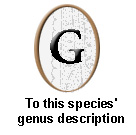|
(Cobb, 1913) Thorne, 1935 
L = 1.1-1.5 mm; a = 22-26; b = 7.4-8.6; c = 48-54; V = 55 0.9-1.3 mm; a = 27-30; b = 6.5-7.0; c = 28-32; T = 42-50
Male smaller and more slender than female. Lip region without tiling, or with only the basal annule divided. Spicula slightly arcuate. Gubernaculum with titillae. Bursa broad, striated, enveloping tail. Hoplolaimus galeatus is generally distributed throughout the region, often in sufficient numbers to cause considerable damage to the roots of wheat and other plants. Feeding is both ectoparasitic and endoparasitic. (Thorne and Malek, 1968 description) DNA Sequences Obtained
|

